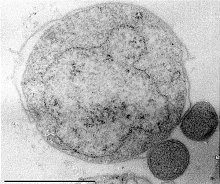Related Research Articles
Archaeoglobus is a genus of the phylum Euryarchaeota. Archaeoglobus can be found in high-temperature oil fields where they may contribute to oil field souring.

Sulfolobus is a genus of microorganism in the family Sulfolobaceae. It belongs to the archaea domain.

The Desulfurococcales are an order of the Thermoprotei, part of the kingdom Archaea. The order encompasses some genera which are all thermophilic, autotrophs which utilise chemical energy, typically by reducing sulfur compounds using hydrogen.
Methanopyrales are an order of microbes within the class methanopyri.

Sulfolobales is an order of archaeans in the class Thermoprotei.
Methanopyraceae are a family of the Methanopyrales. This family contains only one genus, which contains only one species, Methanopyrus kandleri. It is chemolitoautotrophic and its cells are bar-shaped. It can grow comfortably at a temperature of 98 °C and can survive at temperatures as high as 110 °C, making it the most thermophilic known methanogen. It has been found to live in hydrothermal vents.
In taxonomy, the Methanothermaceae are a family of microbes within the order Methanobacteriales.
The Pyrodictiaceae are a family of disc-shaped anaerobic microorganisms belonging to the order Desulfurococcales, in the domain Archaea. Members of this family are distinguished from the other family (Desulfurococcaceae) in the order Desulfurococcales by having an optimal growth temperature above 100 °C, rather than below 100 °C.

Sulfolobaceae are a family of the Sulfolobales belonging to the domain Archaea. The family consists of several genera adapted to survive environmental niches with extreme temperature and low pH conditions.
In taxonomy, the Thermofilaceae are a family of the Thermoproteales.
In taxonomy, Caldivirga is a genus of the Thermoproteaceae.

In taxonomy, Acidianus is a genus of the Sulfolobaceae.
In taxonomy, Metallosphaera is a genus of the Sulfolobaceae.
Sulfurisphaera is a genus of the Sulfolobaceae.
In taxonomy, Aeropyrum is a genus of the Desulfurococcaceae.
In taxonomy, Desulfurococcus is a genus of the Desulfurococcaceae.
In taxonomy, Thermodiscus is a genus of the Desulfurococcaceae.
In taxonomy, Hyperthermus is a genus of the Pyrodictiaceae.
In taxonomy, Methanolobus is a genus of methanogenic archaea within the Methanosarcinaceae. These organisms are strictly anaerobes and live exclusively through the production of methane, but the species within Methanolobus cannot use carbon dioxide with hydrogen, acetate or formate, only methyl compounds. The cells are irregular coccoid in form and approximately 1 μm in diameter. They do not form endospores. They are Gram negative and only some are motile, via a single flagellum. They are found in lake and ocean sediments that lack oxygen.
In taxonomy, Ignisphaera is a genus of the Desulfurococcales. Ignisphaera aggregans is a coccoid- shaped, fourth type strain that is strictly anaerobes with anaerobic respiration. This archaea species are hyperthermophiles that were found in New Zealand's hot springs in Kuirau Park, Rotorua.
References
- ↑ See the NCBI webpage on Stygiolobus. Data extracted from the "NCBI taxonomy resources". National Center for Biotechnology Information . Retrieved 2007-03-19.